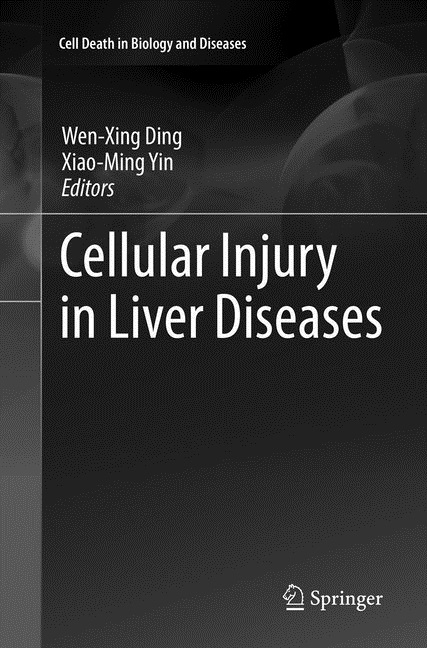Ulteriori informazioni
This volume has gathered together some of the world's experts on cell death in liver diseases, covering topics on a variety of types of liver injury. Specifically, the chapters of this volume describe drug and virus-mediated hepatocyte injury, alcohol, lipid and bile acid-induced hepatocyte injury in addition to ischemia-reperfusion-mediated liver injury. The authors link these different types of liver injury to the commonly associated liver inflammation, fibrosis and tumorigenesis. Other topics explored include the various forms of cell death and cell survival pathways that have been identified in the liver, such as apoptosis, necroptosis, pryoptosis and autophagy. This book, along with its companion volume, Molecules, Systems and Signaling in Hepatic Cell Death, provides a thorough and comprehensive discussion on the topic of cell death and liver disease. Cellular Injury in Liver Diseases is an essential addition to the Cell Death in Biology and Diseases series and will appeal to scientists, clinicians and those doing research for drug discovery.
Sommario
Preface.- 1) Regulation of cell death in Hepatocytes, An overview .- 2) Cell death of cholangiocytes and its role in the development of biliary diseases .- 3) Cell death and autophagy in hepatic stellate cell activation and function .- 4) Regulation of Kupffer's cell death, survival and activation during liver injury .- 5) Drug-induced liver injury (DILI), a general overview .- 6) Mechanisms of acetaminophen-induced liver injury .- 7) HIV-protease inhibitor-induced liver injury .- 8) Mechanisms of Lipotoxicity in Liver Injury .- 9) Cell Death in NAFLD and NASH .- 10) Cell death and autophagy in alcohol-induced liver injury .- 11) Bile acid-induced cell death, cholestasis and liver injury .- 12) Cell death in ischemia-reperfusion induced liver injury .- 13) Lectin (ConA)-induced liver injury and autoimmune hepatitis .- 14) Cell death and autophagy in viral hepatitis .- 15) Cell death and autophagy in liver tumorigenesis and liver cancer.
Info autore
Dr. Wen-Xing Ding is an Associate Professor of Department of Pharmacology, Toxicology and Therapeutics at The University of Kansas Medical Center. He received his Ph.D. from the National University of Singapore. He did his Postdoctoral training at University of Pittsburgh. In the past decade, Dr. Ding's research has been focused on the molecular mechanisms of cell death and autophagy in alcohol and drug-induced liver injury as well as liver tumorigenesis. Dr. Ding is a member of American Association of Studies of Liver Disease (AASLD), Society of Toxicology (SOT) and Research society of Alcoholism. Dr. Ding was a Liver Scholar of American Liver Foundation and a recipient of University Scholarly Achievement Award. Dr. Ding has published more than 100 papers in peer-reviewed journals and his research work is currently supported by NIAAA and NIDDK.
Dr. Xiao-Ming Yin is the Louis Y. Mazzini Professor of Pathology at the Department of Pathology andLaboratory Medicine, Indiana University School of Medicine. He obtained his medical degree from Shanghai Medical University and his PhD degree from University of Texas Southwestern Medical Center at Dallas. He completed his post-doctoral fellow training and his pathology residency training at Washington University in St. Louis. Dr. Yin is a member of several scientific societies and is a fellow of American Association of Studies of Liver Disease (AASLD). He has won the Outstanding Investigator Award from American Society for Investigative Pathology (ASIP). His research interest is the cell death and survival in tissue injury and cancer biology, particularly in the liver system.
Riassunto
This volume has gathered together some of the world’s experts on cell death in liver diseases, covering topics on a variety of types of liver injury. Specifically, the chapters of this volume describe drug and virus-mediated hepatocyte injury, alcohol, lipid and bile acid-induced hepatocyte injury in addition to ischemia-reperfusion-mediated liver injury. The authors link these different types of liver injury to the commonly associated liver inflammation, fibrosis and tumorigenesis. Other topics explored include the various forms of cell death and cell survival pathways that have been identified in the liver, such as apoptosis, necroptosis, pryoptosis and autophagy. This book, along with its companion volume, Molecules, Systems and Signaling in Hepatic Cell Death, provides a thorough and comprehensive discussion on the topic of cell death and liver disease. Cellular Injury in Liver Diseases is an essential addition to the Cell Death in Biology and Diseases series and will appeal to scientists, clinicians and those doing research for drug discovery.

